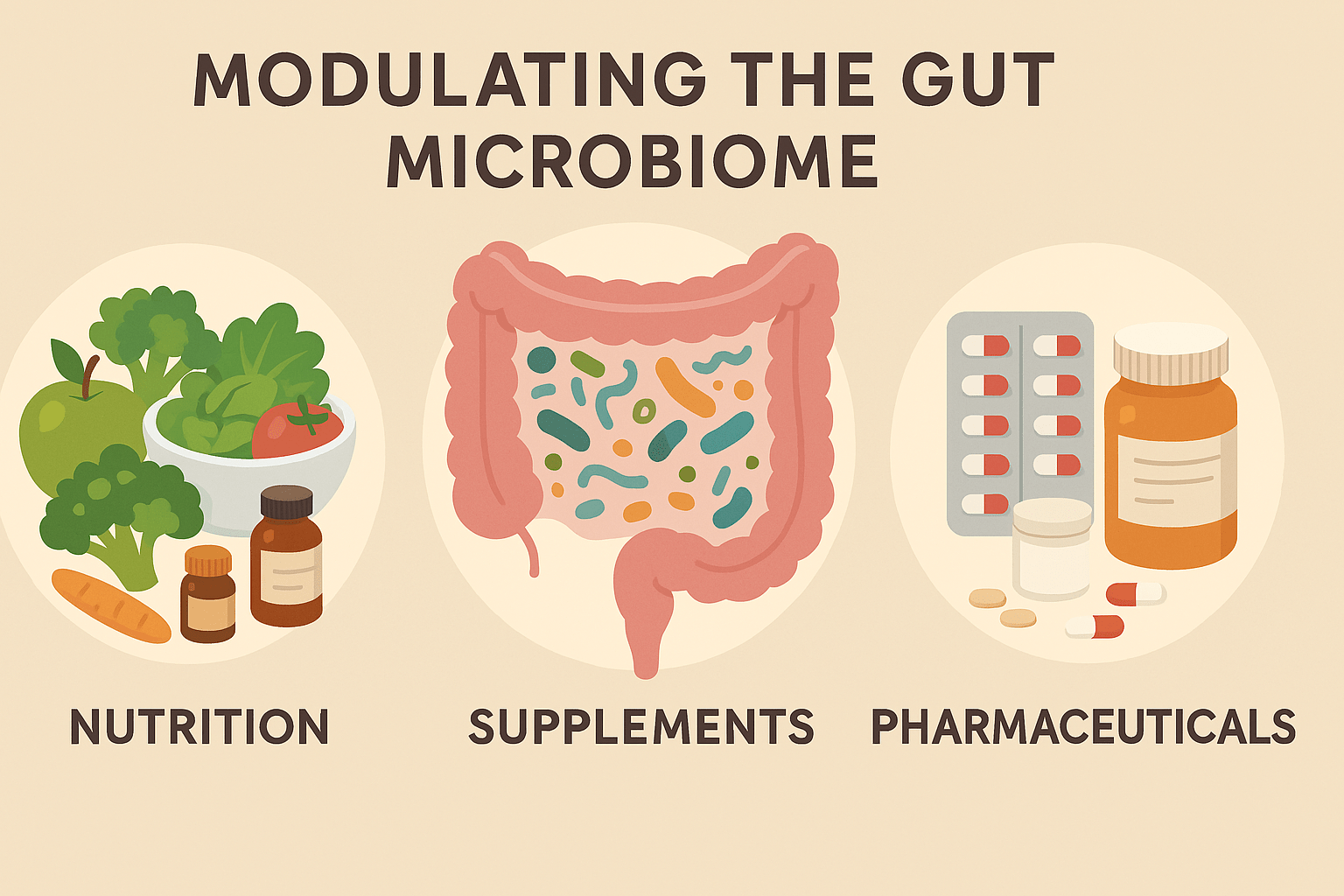
Modulating the gut microbiome with nutrition, food supplements or pharmaceutical pills?
Discover the three key methods to modulate your gut microbiome—nutrition, supplements, and pharmaceuticals. Learn how each approach works, their pros and cons, and which is most effective for different health goals.
Introduction
The gut microbiome, comprising trillions of microorganisms, plays a pivotal role in human health, influencing digestion, immunity, and even mental well-being. With growing evidence of its impact on various medical conditions, modulating the gut microbiome has become a focal point in both scientific research and public interest. Three primary methods have emerged as effective tools for influencing gut microbiota: nutrition, food supplements, and pharmaceutical interventions. Each approach comes with its own strengths, limitations, and optimal use cases.
In this comprehensive blog post, we will delve into each method, comparing their efficacy, mechanisms, advantages, and drawbacks. By the end, you'll gain a clearer understanding of which method is best suited for different health scenarios and how these interventions may shape the future of personalized medicine.
Part 1: Modulating the Gut Microbiome Through Nutrition
Mechanisms and Effects
Diet is arguably the most accessible and sustainable way to influence gut microbiota. Dietary components such as fiber, polyphenols, fermented foods, and macronutrient balance can significantly alter microbial diversity and function. High-fiber diets, for example, promote the growth of beneficial bacteria like Bifidobacterium and Faecalibacterium prausnitzii, which produce short-chain fatty acids (SCFAs) that support gut integrity and reduce inflammation.
Positive Aspects
-
Sustainable: Changes in diet can have long-term effects on the microbiome.
-
Accessible: No need for prescriptions or expensive interventions.
-
Holistic: Supports overall health, not just the microbiome.
-
Preventive: Can reduce the risk of diseases like obesity, type 2 diabetes, and colorectal cancer.
Challenges and Limitations
-
Slow Response Time: It may take weeks or months to see significant microbiota changes.
-
Compliance Issues: Adhering to dietary changes long-term can be difficult.
-
Individual Variation: Microbiome responses vary greatly between individuals.
Best Use Cases
-
Chronic disease prevention
-
Maintenance of gut health
-
Support during lifestyle interventions (e.g., weight loss)
Part 2: Modulating the Gut Microbiome Through Food Supplements
Mechanisms and Effects
Food supplements, particularly probiotics, prebiotics, and synbiotics, are designed to modulate the microbiome by adding beneficial bacteria (probiotics), feeding existing beneficial bacteria (prebiotics), or combining both (synbiotics). These supplements are widely available and often used for gastrointestinal complaints and immune support.
Positive Aspects
-
Targeted: Can be formulated to address specific health issues.
-
Convenient: Easy to consume and integrate into daily routines.
-
Safe: Generally regarded as safe for most populations.
-
Backed by Evidence: Many clinical trials support the use of specific strains for conditions like IBS and antibiotic-associated diarrhea.
Challenges and Limitations
-
Transient Effects: Many probiotics do not colonize the gut permanently.
-
Quality Control: Potency and viability can vary between products.
-
Strain-Specific Effects: Benefits are not generalizable across all strains.
Best Use Cases
-
IBS and other functional GI disorders
-
During or after antibiotic use
-
Travel-related digestive issues
Part 3: Modulating the Gut Microbiome Through Pharmaceutical Pills
Mechanisms and Effects
Pharmaceutical interventions include microbiota-targeted therapies such as fecal microbiota transplantation (FMT), bacteriophage therapy, and microbial metabolite modulators. These are usually used in clinical settings and are aimed at treating specific diseases with a high degree of precision.
Positive Aspects
-
High Efficacy: Can lead to rapid and significant microbiome shifts.
-
Targeted Action: Designed for particular pathogens or microbial imbalances.
-
Therapeutic Potential: Effective for treatment-resistant infections like Clostridioides difficile.
Challenges and Limitations
-
Cost and Accessibility: Often expensive and not widely available.
-
Side Effects: Potential for adverse effects, especially with FMT.
-
Regulatory Issues: Varying approval status across countries.
Best Use Cases
-
Recurrent C. difficile infection
-
Severe dysbiosis unresponsive to other treatments
-
Precision medicine for chronic diseases
Comparative Overview
| Modulation Method | Best For | Strengths | Limitations |
|---|---|---|---|
| Nutrition | Preventive care, chronic health | Sustainable, holistic, accessible | Slow, variable response |
| Food Supplements | GI disorders, immune support | Convenient, targeted, well-tolerated | Effects often short-lived |
| Pharmaceuticals | Severe or resistant conditions | Potent, fast-acting, disease-specific | Cost, access, potential side effects |
Conclusion: Which Is Most Impactful and When?
No single method is universally superior; the most effective strategy depends on the health context and individual patient needs.
-
Nutrition is the foundation for long-term health and disease prevention.
-
Supplements are effective for addressing moderate imbalances or enhancing resilience during stress.
-
Pharmaceuticals are reserved for severe cases requiring targeted, high-impact intervention.
An integrated approach that combines dietary changes with evidence-based supplements and, when necessary, pharmaceutical treatments may offer the most comprehensive benefits for gut health. Personalized gut microbiome modulation, guided by diagnostics and patient history, represents the future of precision medicine.
Stay tuned as research continues to uncover new ways to harness the gut microbiome for better health outcomes.

